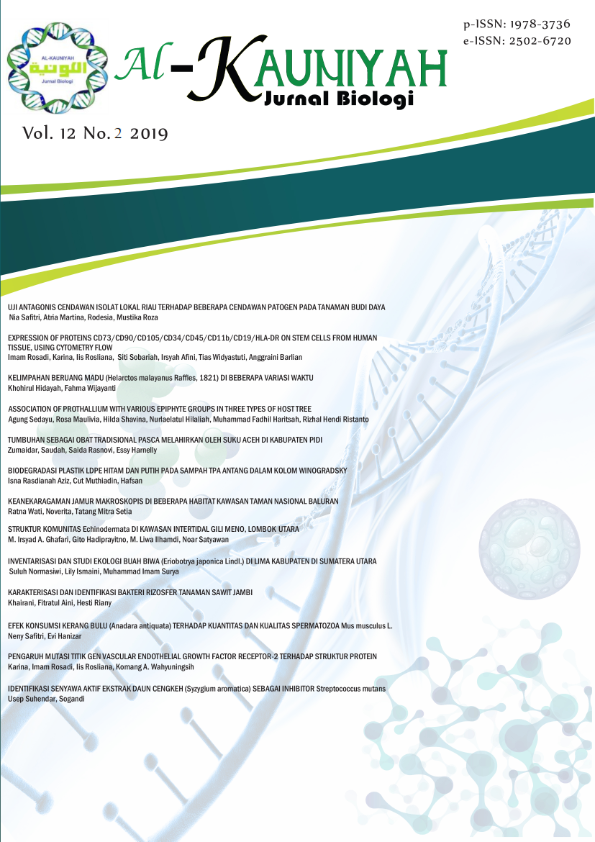STUDI IN SILICO: PREDIKSI PENGARUH MUTASI TITIK GEN VASCULAR ENDOTHELIAL GROWTH FACTOR RECEPTOR-2 (VEGFR2) TERHADAP STRUKTUR SEKUNDER PROTEIN
DOI:
https://doi.org/10.15408/kauniyah.v12i2.11804Keywords:
Angiogenesis, hemangioma, mutasi, VEGF, VEGFR2Abstract
Angiogenesis merupakan proses penting untuk pertumbuhan dan regenerasi sel. Salah satu protein yang berperan dalam angiogenesis adalah vascular endothelial growth factor (VEGF). VEGF akan berinteraksi dengan reseptornya seperti vascular endothelial growth factor receptor-2 (VEGFR2) untuk meregulasi proses angiogenesis. Mutasi pada gen VEGFR2 pada manusia dilaporkan dapat menyebabkan penyakit strawberry mark (hemangioma). Oleh karena itu, perlu dilakukan studi dan penelusuran terkait mutasi yang berperan dalam terbentuknya hemangioma. Beberapa tahapan yang dilakukan untuk menganalisis pengaruh mutasi tersebut diantaranya dengan melakukan penelusuran informasi dasar dan komposisi gen VEGFR2, analisis ortolog dan paralog gen VEGFR2, dan analisis struktur sekunder protein VEGFR2 manusia. Hasilnya menunjukkan bahwa mutasi VEGFR2 pada basa ke-3741 yaitu sitosin (C) menjadi timin (T) dilaporkan ditemukan pada jaringan tumor hemangioma. Perubahan basa ke-3741 sitosin menjadi timin mengakibatkan perubahan asam amino prolin menjadi serin yang dapat berdampak pada regulasi ekspresi VEGF. Ortolog dan paralog dari gen VEGFR2 manusia adalah gen VEGFR2 mencit dan gen fibroblast growth factor receptor 1 (FGFR1) manusia. Hasil analisis pengaruh mutasi terhadap bentuk dan struktur protein menunjukkan tidak ada perubahan yang signifikan, namun posisi mutasi di bagian ekstraseluler sel diduga mempengaruhi regulasi ekspresi VEGF melalui ikatan ligan-reseptor.References
Bauland, C.G., Van Steensel, M.A., Steijlen, P.M., Rieu, P.N., & Spauwen, P.H. (2006). The pathogenesis of hemangiomas: A review. Plastic and reconstructive surgery, 117(2), 29−35e.
Callahan, A.B., & Yoon, M.K. (2012). Infantile hemangiomas: A review. Saudi Journal of Ophthalmology, 26(3), 283−291.
Cebe-Suarez, S., Zehnder-Fjällman, A., Ballmer-Hofer, K. (2006). The role of VEGF receptors in angiogenesis; complex partnerships. Cellular and molecular life sciences, 63(5), 601−615.
Ferrara, N., Gerber, H.P., LeCouter, J. (2003). The biology of VEGF and its receptors. Nature medicine, 9(6), 669−676.
Holmes, D.I., Zachary, I. (2005). The vascular endothelial growth factor (VEGF) family: Angiogenic factors in health and disease. Genome biology, 6(2), 209-218.
Hu, Y., Blair, J.D., Yuen, R.K., Robinson, W.P., von Dadelszen, P. (2015). Genome-wide DNA methylation identifies trophoblast invasion-related genes: Claudin-4 and Fucosyltransferase IV control mobility via altering matrix metalloproteinase activity. Molecular human reproduction, 21(5), 452−465.
Huang, S.C., Zhang, L., Sung, Y.S., Chen, C.L., Kao, Y.C., Agaram, N.P. (2016). Recurrent CIC gene abnormalities in angiosarcomas: a molecular study of 120 cases with concurrent investigation of PLCG1, KDR, MYC, and FLT4 gene alterations. The American journal of surgical pathology, 40(5), 645−655.
Kleinman, M.E., Tepper, O.M., Capla, J.M., Bhatt, K.A., Ceradini, D.J., Galiano, R.D. (2003). Increased circulating AC133+/CD34+ endothelial progenitor cells in children with hemangioma. Lymphat Res Biol, 1, 301-307.
Kumar, S., & Gadagkar, S.R. (2000). Efficiency of the neighbor-joining method in reconstructing deep and shallow evolutionary relationships in large phylogenies. Journal of Molecular Evolution, 51(6), 544−553.
Nicolae, C., & Olsen, B.R. (2010). Unexpected matrix diseases and novel therapeutic strategies. Cell Tissue Res, 339, 155-165.
Olsson, A.K., Dimberg, A., Kreuger, J., Claesson-Welsh, L. (2006). VEGF receptor signalling? In control of vascular function. Nature reviews Molecular cell biology, 7(5), 359−371.
Ou, J.M., Yu, Z.Y., Qiu, M.K., Dai, Y.X., Dong, Q., Shen, J. (2014). Knockdown of VEGFR2 inhibits proliferation and induces apoptosis in hemangioma-derived endothelial cells. European Journal of Histochemistry, 58(2263), 65−72.
Qiu, S., Wu, T., Wang, P., Li, J., Li, Q., Du, J. (2016). The Association between VEGFR Gene Polymorphisms and Stroke: A Meta-Analysis. PloS one. 2016;11(3), 1-17.
Shibuya, M. (2011). Vascular endothelial growth factor (VEGF) and its receptor (VEGFR) signaling in angiogenesis a crucial target for anti-and pro-angiogenic therapies. Genes & cancer, 2(12), 1097−1105.
Tabata, S., Goi, T., Nakazawa, T., Kimura, Y., Katayama, K., Yamaguchi, A. (2013). Endocrine gland-derived vascular endothelial growth factor strengthens cell invasion ability via prokineticin receptor 2 in colon cancer cell lines. Oncology Reports, 29, 459-463.
Thieman, W.J., & Palladino, M.A. (2013). Introduction to Biotechnology. Third Edition. US: Pearson.
Walter, J.W., North, P.E., Waner, M., Mizeracki, A., Blei, F., Walker, J.W. (2002). Somatic mutation of vascular endothelial growth factor receptors in juvenile hemangioma. Genes, chromosomes and cancer, 33(3), 295−303.

